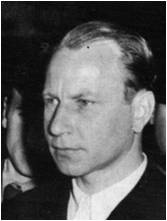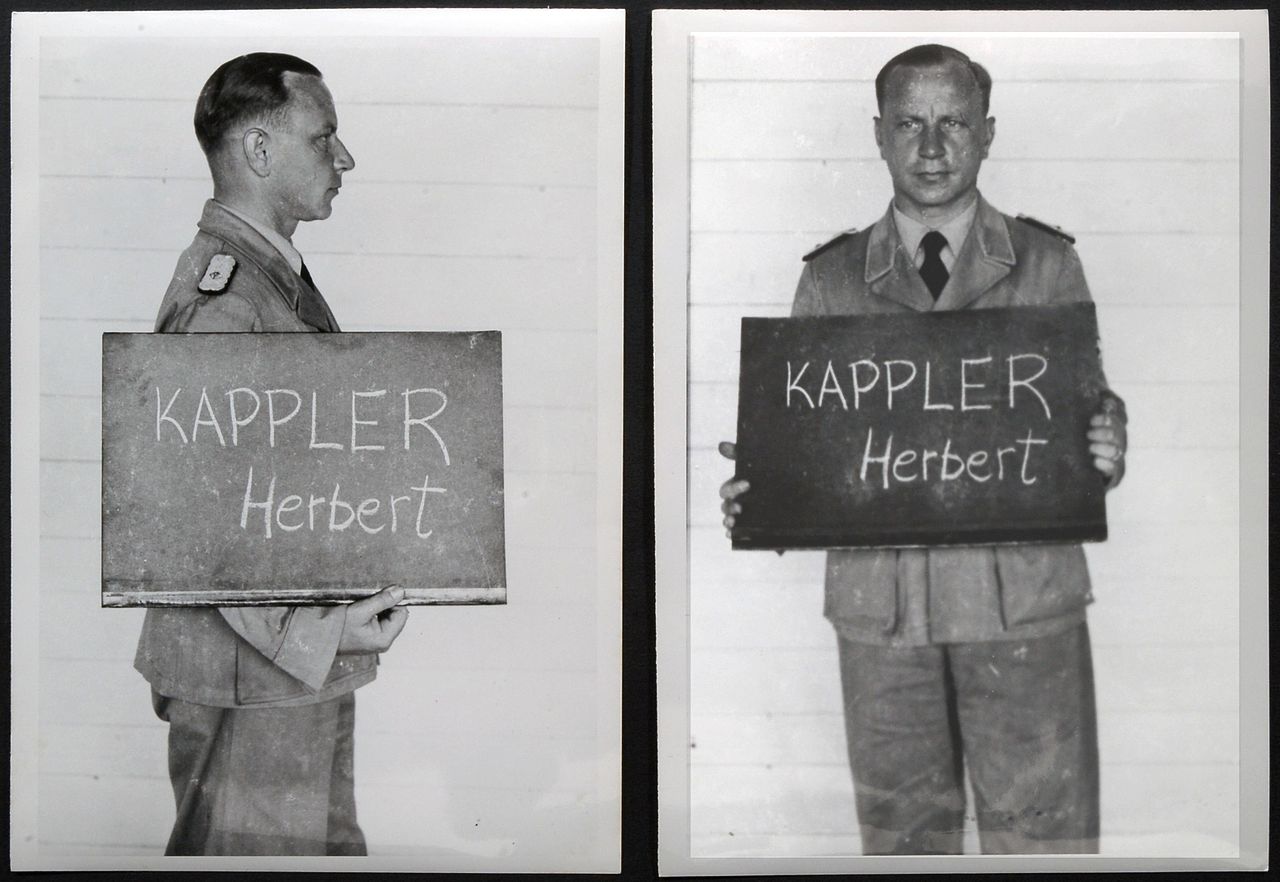<Back to Index>
- Head of German Police and Security Services in Rome Herbert Kappler, 1907
PAGE SPONSOR


Herbert Kappler (23 September 1907 - 9 February 1978) was the head of German police and security services (Oberbefehlshaber des Sicherheitspolizei und SD) in Rome during World War II. He rose to the rank of SS - Obersturmbannführer and was responsible for the Ardeatine massacre as well as dealing with Vatican City over its neutrality.
Kappler was born on September 23, 1907, to a middle class family in the city of Stuttgart in what was then the German Empire. During his childhood, Kappler witnessed World War I, and came of age in the Weimar Republic during the 1920s. Kappler attended four years of elementary school (Volksschule) followed by four more of high school and graduated in 1925. He next attended a technical college and spent seven semesters studying electrical engineering. By 1929, he was a certified electrician, still living in Stuttgart.
Kappler's activities between 1929 and 1931 are little known, except that he was living in Stuttgart, occasionally performing work as an electrician. Living in a major city such as Stuttgart, Kappler was a witness to the chaos of the Great Depression, the expansion of the Freikorps, and the rise of the Nazi Party. In 1931, Herbert Kappler formally became a Nazi Party member.
Herbert Kappler joined the Nazi Party on August 1, 1931 at the age of twenty three. At the same time, he became a stormtrooper in the Sturmabteilung (SA) and served as an SA - Mann from August 1, 1931 to December 1, 1932. His Nazi Party membership number was 594,899.
Upon leaving the SA, Kappler was accepted as a prospective candidate into the Schutzstaffel (SS) and appointed to the entry level probation rank of SS - Anwärter. He underwent six months of indoctrination training, and was sworn into the SS on May 8, 1933. During Kappler's probationary period, Adolf Hitler became Chancellor of Germany, meaning that Kappler did not have the "honor" of full SS membership prior to the Nazis' assumption of power. Even so, due to his membership in the SA and Nazi Party dating from 1931, Kappler was considered an Alter Kämpfer and awarded the Honour Chevron for the Old Guard in 1934.
After serving as an SS - Anwärter from December 1932 to May 1933, Kappler was appointed an SS-Mann and assigned the SS membership number 55,211. His first assignment was as a member of an Allgemeine SS formation (the 13th SS - Standarte), operating out of Stuttgart, performing part time duties as a member of the general SS.
Kappler was also in Stuttgart during the Night of the Long Knives, but was at this time too junior in the SS to significantly participate. Towards the end of 1934, on September 29, he married Leonore Janns who was the same age as Kappler (27 at the time) and came from the city of Heilbronn. The two lived at an address on Tübingern, Kurzestrasse 15, before later moving to an apartment listed at Stuttgart - Degerloch, Reutlingerstrasse 98.
In 1935, as part of Germany's rearming programs, Kappler was called up to serve in the Wehrmacht. Since he was at this time considered only a general SS member, not assigned to permanent full time duties, Kappler was not exempt from the draft and he became a Schütze in the Wehrmacht on June 11, 1935. Kappler performed active training duty over three separate periods from June 1935 to September 1936, with final release on September 27, 1936 with the rank of Feldwebel der Reserve. Kappler was never discharged and technically held this rank during World War II, although by that time Kappler was an active full time SS member and exempt from further military service. Kappler was also never affiliated with the Waffen - SS and spent the war performing "behind the lines" police and security duty.
In mid 1935, Kappler applied for transfer to the full time SS and submitted an application to join the Sicherheitspolizei (Security Police) or SiPo. In January 1936, he was promoted to the rank of SS - Scharführer (sergeant) and assigned to duty at the Gestapo main office of Stuttgart (Stapoleitstelle Stuttgart). Over the next year, Kappler began to be noticed by his superiors and was introduced to Reinhard Heydrich (although some sources state Kappler knew Heydrich for some time before). In 1937, Kappler (now an SS - Oberscharführer (staff sergeant)) was sent by his Gestapo superiors to attend the Führerschule der Sicherheitspolzei (Leadership School of the Security Police) in Berlin from which he graduated in the summer of 1937 as a certified Kriminalkommissar (Criminal Commissioner). This set the stage for further advancement and Kappler was commissioned a Gestapo officer, with the rank of SS - Untersturmführer (second lieutenant), on November 9, 1938 (the traditional anniversary of the Munich Beer Hall Putsch).
Upon the outbreak of World War II, in September 1939, Kappler was serving as an SS - Hauptsturmführer (captain) out of the Stuttgart Gestapo main office. From 1939 to 1940, he was briefly deployed to Poland and participated in various Einsatzgruppen actions before serving a further tour as a uniformed Gestapo officer in occupied Belgium where he acted to suppress resistance. In 1941, after the implementation of "Final Solution" directives resulting from the Wannsee Conference, Kappler began to coordinate Jewish round-ups and deportations to death camps in eastern Europe.
In mid 1941, now an SS - Major, Kappler was selected as a liaison officer to the government of Benito Mussolini as well as a security advisor to the Fascist police. His appointment to Italy was the result of his security police experience, connections with the SS leadership (Reinhard Heydrich, in particular), as well as a fluency in the Italian language.
Following the armistice between Italy and the Allied Forces on September 8, 1943, the German military occupied Rome and Kappler was ordered to serve as Chief of the Security Police and Security Service (Oberbefehlshaber des Sicherheitspolizei und SD) for all SS and police units deployed in Rome. He was promoted to SS - Obersturmbannführer (lieutenant colonel) on September 12 and quickly assumed his new duties operating out of the Italian capital.
Kappler's first action as head of German security forces in Rome was to help plan the rescue of Benito Mussolini by the SS special forces, a feat which was accomplished by Otto Skorzeny. Kappler was next entrusted with Jewish roundups for transportation to Auschwitz; in his first action, 1,007 Italian Jews were deported with only 16 surviving, and Kappler would later arrange the deportation of a further ten thousand Roman Jews, nearly all of whom would eventually perish in Nazi gas chambers.
By early 1944, Kappler was the highest representative of the Reichssicherheitshauptamt (Reich Main Security Office) in Rome and answered directly to both the military governorship, under Luftwaffe Major General Kurt Mälzer, as well as the SS chain of command under the Supreme SS and Police Leader of Italy, SS - Obergruppenführer Karl Wolff. Kappler's main activities during this period involved suppressing resistance groups, rounding up "enemies of the state", and enforcing anti - Jewish measures, conducting Jewish ghetto raids, and deportations to extermination camps.
As the Allied armies invaded Italy and began moving north towards Rome, Kappler became significantly involved in hunting suspected Allied agents and Allied prisoners - of - war which had escaped Italian POW camps after the Italian Army capitulated. In these measures, Kappler came into direct conflict with the Vatican, which was highly suspected of harboring Allied fugitives and escaped prisoners, even though the Vatican under Pope Pius XII was technically neutral. A particular adversary of Kappler's in this respect was Monsignor Hugh O'Flaherty, whose activities helping Jewish fugitives and Allied prisoners escape Rome led to Kappler having him targeted for assassination. Paradoxically, after the war Kappler and O'Flaherty would become friends of sorts.
One of the most notorious actions Kappler undertook while in Rome was the organization of the Ardeatine massacre where over three hundred Italian civilians were killed on March 24, 1944 in collective punishment for an attack by resistance fighters against an SS formation in Rome.
As Rome fell to Allied forces, Kappler unsuccessfully tried to seek refuge in the Vatican, but he was arrested by British authorities in 1945 and later turned over to the Italian government in 1947. Kappler's second in command in Rome, SS - Captain Erich Priebke, did manage to escape and it was not until 1996 that Priebke would face justice.
In 1947, Kappler was tried by an Italian military tribunal and sentenced to life imprisonment in the military prison of Gaeta. Kappler and his first wife divorced while Kappler was serving his sentence, but he was married again to Anneliese Kappler, a nurse who had carried on a lengthy correspondence with Kappler before marrying him in a prison wedding ceremony in 1972. By this time Kappler had also converted to Catholicism partly due to the influence of his war time opponent, the Vatican diplomat Mgr Hugh O'Flaherty, who often visited Kappler in prison, discussing literature and religion with him.
By 1975, at the age of sixty - eight, Kappler was diagnosed with terminal cancer and he was moved to a military hospital in Rome in 1976. Appeals by both his wife and the West German government to release him were denied by Italian authorities.
Because of Kappler's deteriorating condition and his wife's nursing skills, Anneliese Kappler had been allowed almost unlimited access to him during his time in the Italian hospital. On a prison visit in August 1977, Kappler's wife carried him out in a large suitcase (Kappler weighed less than 105 pounds at the time) and escaped to West Germany, assisted by apparently unwitting carabinieri.
The Italians unsuccessfully demanded that Kappler be returned, but the West Germany authorities refused to extradite him and did not prosecute Kappler for any further war crimes, reportedly due to his ill health.
Six months after his escape, Kappler died at home in Soltau, on February 9, 1978, aged 70.